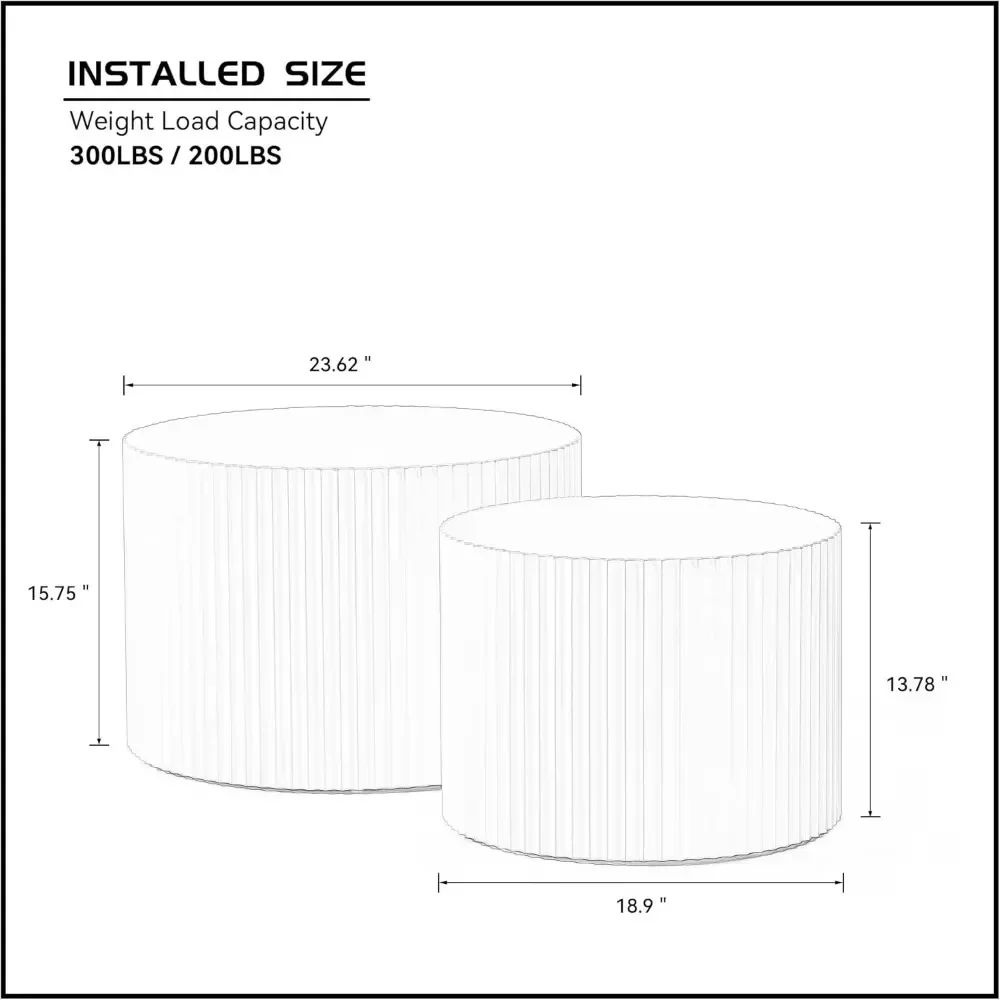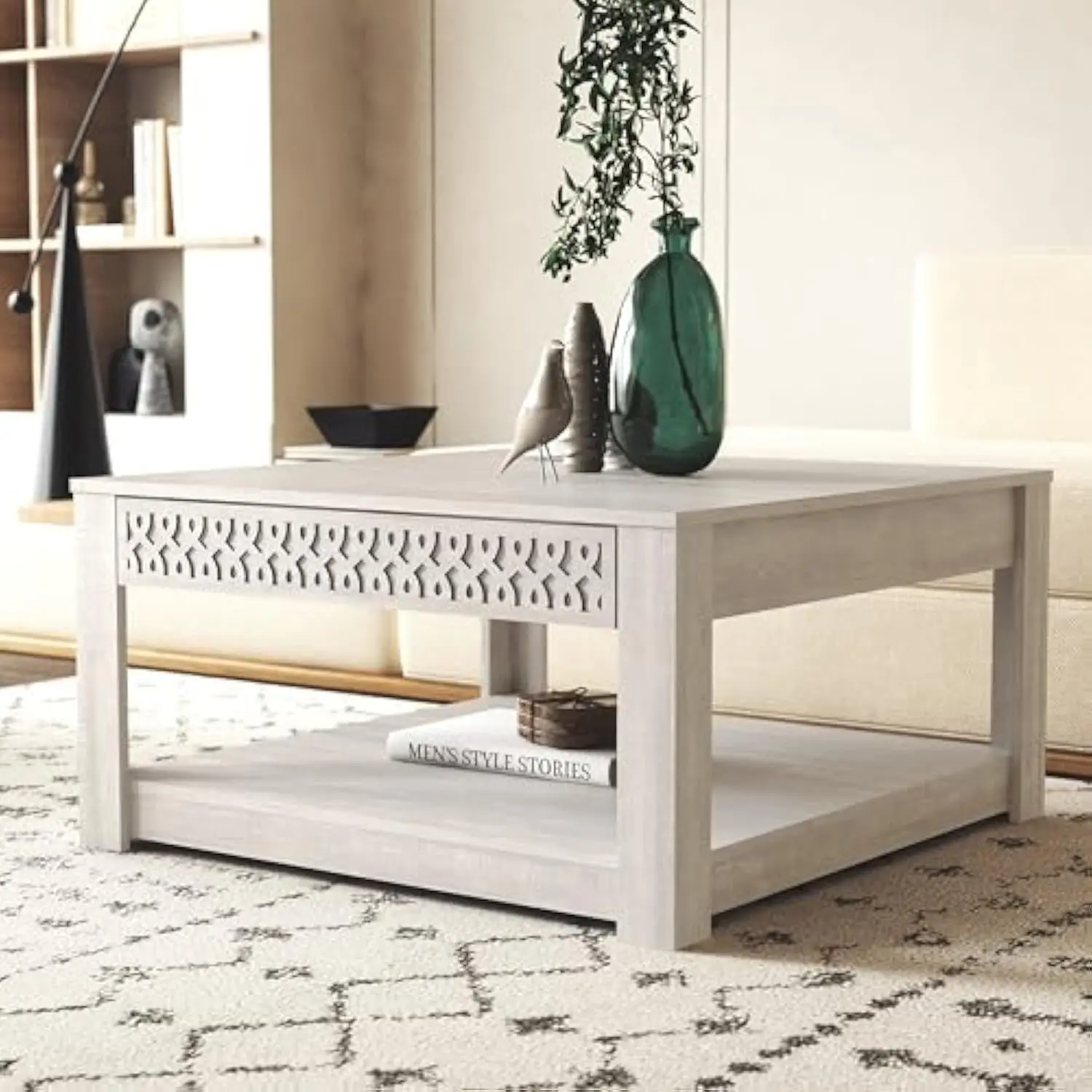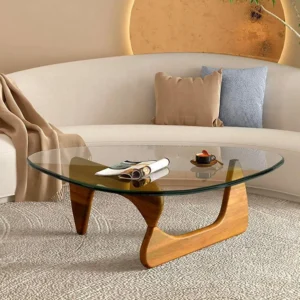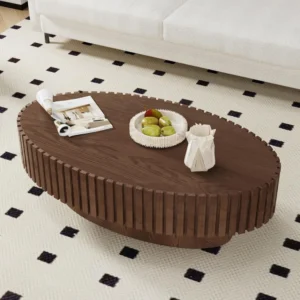1. The Distinctive Appeal of Walnut Coffee Tables
Walnut stands out as one of the most sought-after hardwoods in furniture making, and for good reason. Its rich chocolate-brown hues, striking grain patterns, and remarkable durability make it an exceptional choice for quality furniture. Unlike lighter woods that can appear commonplace, walnut brings a sense of warmth and sophistication to any living space.
What truly sets walnut apart is its natural aging process. Unlike many woods that fade, walnut actually darkens and develops a deeper patina over time, enhancing its beauty through the years. This distinctive characteristic makes walnut coffee tables not just furniture pieces but genuine investments that improve with age.
When shopping for a walnut coffee table, understanding the specific features to compare becomes crucial. Not all walnut tables are created equal, and recognizing the differences in material quality, construction methods, and design elements can help you make a choice you’ll appreciate for decades. Many black mid-century coffee tables incorporate walnut elements, demonstrating its versatility across design styles.
Throughout this guide, we’ll explore what makes premium walnut coffee tables truly special, from material authenticity to dimensions, design elements, and practical considerations that ensure you select the perfect centerpiece for your living space.
2. Material Authenticity: Identifying True Walnut Quality
Understanding the difference between various walnut materials is perhaps the most critical comparison point when evaluating coffee tables. This distinction directly impacts everything from appearance to longevity and value retention.
Solid walnut represents the premium choice, crafted from lumber cut directly from walnut trees. These pieces showcase authentic grain patterns throughout the entire structure—not just on visible surfaces. When you examine a solid walnut table, you’ll notice consistent grain patterns even on edges and undersides. This material can be refinished multiple times over decades, allowing for restoration after wear.
Walnut veneer offers a middle-ground option, featuring a thin layer of genuine walnut wood applied over an engineered core (typically plywood or MDF). Quality veneer work can be quite beautiful and more affordable than solid walnut, though it cannot be repeatedly refinished like solid wood. Look for thick veneers (at least 2mm) that won’t easily wear through.
The most budget-friendly option—walnut-finished engineered wood—contains no actual walnut at all. These pieces use printed grain patterns and stains to mimic walnut’s appearance. While they may look convincing at first glance, they typically lack depth in grain patterns and cannot be refinished.
| Material Type | Visual Characteristics | Durability | Price Range | Best Uses |
|---|---|---|---|---|
| Solid Walnut | Deep, varied grain patterns; consistent coloring throughout; visible end grain | Excellent (50+ years with proper care) | $800-$3000+ | Heirloom pieces; high-traffic areas; long-term investment |
| Walnut Veneer | Attractive surface grain; uniform pattern application; plywood edges visible unless banded | Good (15-25 years) | $300-$900 | Style-conscious spaces; moderate use; budget-conscious quality |
| Engineered Wood | Repetitive grain patterns; uniform color; plastic-like edge appearance | Fair (5-10 years) | $150-$500 | Temporary solutions; rental properties; light use areas |
The manufacturing process significantly impacts quality regardless of material type. Premium solid wood coffee tables use proper kiln-drying techniques that stabilize the wood and prevent future warping or cracking. When evaluating tables, inquire about moisture content and drying methods—properly dried walnut should have 6-8% moisture content for indoor furniture.
3. Dimensioning for Your Space: Finding the Perfect Proportions
Finding the right dimensions for your walnut coffee table makes the difference between a harmonious living space and one that feels awkward or unbalanced. Standard coffee table heights typically range between 16-18 inches (40-45 cm), ideally sitting 1-2 inches below your sofa seat height. This relationship creates both visual balance and functional convenience for placing and retrieving items.
Length proportions matter significantly for visual harmony. Generally, your coffee table should measure approximately one-half to two-thirds the length of your sofa. This proportion creates balanced negative space while ensuring the table is accessible from all seating positions.
Consider these space-specific recommendations:
Small spaces (under 150 sq ft/14 sq m): Choose tables 36-42 inches (91-107 cm) long and no more than 24 inches (61 cm) wide. Round or oval tables with a diameter of 30-36 inches (76-91 cm) work well by eliminating sharp corners.
Medium spaces (150-300 sq ft/14-28 sq m): Rectangular tables 48-54 inches (122-137 cm) long provide adequate surface area without overwhelming the room. Width should remain proportionate at 24-30 inches (61-76 cm).
Large spaces (over 300 sq ft/28 sq m): Substantial tables 60+ inches (152+ cm) long help anchor expansive seating arrangements. Consider width up to 36 inches (91 cm) for proper scale.
Always maintain minimum clearance of 18 inches (45 cm) between your coffee table and surrounding furniture. This spacing ensures comfortable traffic flow while allowing enough room to extend legs when seated. The best shape coffee table for small spaces often incorporates space-saving features like tucked-in legs or compact dimensions.
Remember that scale must consider not just room size but also the proportions of your existing furniture. A delicate table can look diminutive and lost when paired with an overstuffed sectional, while a massive table might overwhelm more streamlined seating.
4. Shapes and Design Elements: Beyond the Rectangle

While rectangular coffee tables remain the most common choice, exploring different shapes can dramatically change both the functionality and visual impact of your living space. Each shape creates a distinct effect and serves different practical purposes.
Rectangular tables offer maximum surface area and familiar proportions that work well with standard sofa arrangements. They provide clear organization of space and traditional visual balance, though they may create traffic flow challenges in tight spaces due to corners.
Round tables eliminate sharp corners—ideal for homes with children or tight spaces where traffic flow is a concern. They promote conversation by creating equal accessibility from all sides and add a softer visual element to rooms dominated by straight lines and angles.
The ongoing debate between oval vs rectangular coffee tables centers on this balance between space efficiency and visual softness. Oval tables combine the flow benefits of round tables with the increased surface area of rectangular designs.
Square tables work particularly well with sectional arrangements or when creating distinct conversation zones with multiple seating pieces. They provide balanced proportions but can be challenging to navigate around in smaller spaces.
Edge treatments significantly impact both safety and style. Consider these options:
- Squared edges: Create a clean, contemporary look but may be uncomfortable for resting arms
- Beveled edges: Offer a sophisticated detail while softening the visual weight
- Rounded edges: Provide safety for households with children while maintaining clean lines
Base and leg designs contribute substantially to a table’s overall aesthetic:
- Tapered legs: A hallmark of mid-century design, creating visual lightness
- Hairpin legs: Industrial-inspired elements that minimize visual mass
- Pedestal bases: Statement-making supports that maximize legroom
- Solid bases: Create substantial presence and maximum stability
Round coffee tables often incorporate distinctive base designs to offset their simpler top shapes. These design elements unite to create the table’s overall aesthetic impression and practical functionality.
5. Storage Solutions: Functionality Meets Form
Beyond surface space, many walnut coffee tables incorporate thoughtful storage features that enhance their practical value. These storage elements should align with your specific lifestyle needs while maintaining the table’s aesthetic integrity.
Consider these common storage configurations:
Open shelves: Provide accessible storage and display space for books, magazines, and decorative items. They maintain visual lightness but require more styling attention since contents remain visible.
Drawers: Offer concealed storage for remote controls, coasters, and other small items you want nearby but out of sight. Quality drawer construction should feature smooth glides, dovetail joinery, and proper stops.
Lift-tops: Create transformable surfaces that raise to comfortable heights for dining, working, or laptop use. These mechanisms should operate smoothly and lock securely in the raised position.
Hidden compartments: Provide clever storage solutions that maintain clean lines and minimal appearances. Look for thoughtfully engineered access methods that won’t loosen or deteriorate with regular use.
Lift-top coffee tables have gained popularity for their versatility in modern homes where spaces often serve multiple functions. The engineering behind these mechanisms significantly affects long-term durability—look for metal components, smooth operation, and solid locking mechanisms.
When evaluating storage features, consider construction quality indicators like:
- Full-extension drawer slides for complete access
- Soft-close mechanisms for refined operation
- Consistent wood grain matching inside drawers and on interior surfaces
- Proper dust panels between drawers in multi-drawer designs
The weight and stability of storage-equipped tables becomes particularly important. Tables with drawers or lift mechanisms should feel solid and balanced, without wobbling or shifting during normal use. Our collection of lift-top coffee tables demonstrates how functionality can complement rather than compromise design.
6. Finish and Surface Treatments: Protection and Aesthetics
The finish applied to your walnut coffee table not only determines its final appearance but also its durability and maintenance requirements. Different finishes highlight walnut’s natural characteristics in distinct ways while offering varying levels of protection.
Matte finishes reduce light reflection, emphasizing the wood’s natural texture while concealing minor imperfections. These finishes offer a contemporary, understated look that many find appealing in modern spaces. However, they may show fingerprints more readily and provide less moisture protection than higher-sheen alternatives.
Satin finishes strike an excellent balance, offering moderate light reflection with good durability. This middle-ground option has become increasingly popular for its ability to highlight grain patterns while providing reasonable protection against daily use.
Gloss finishes create dramatic, reflective surfaces that emphasize color depth and create visual impact. While visually striking, high-gloss surfaces show dust and fingerprints more readily and can sometimes distract from the natural beauty of the wood grain.
Oil-based finishes penetrate the wood surface, enhancing grain patterns and color depth while maintaining a natural feel. These finishes are easy to touch up but require more frequent maintenance and offer less protection against spills.
Lacquer and varnish create protective film barriers on the wood surface, offering excellent protection but less “natural” wood feel. Modern water-based versions provide good protection with lower toxicity and odor.
When comparing black mid-century coffee tables to walnut versions, you’ll notice finish plays an even more critical role in black pieces, where the underlying wood grain may be partially or completely obscured.
For practical evaluation, consider these factors:
- Water resistance: Will the finish develop white spots from water glasses?
- Heat resistance: Can the surface withstand warm cups without damage?
- Scratch resistance: How easily will normal use leave visible marks?
- Repairability: Can minor damage be touched up without complete refinishing?
The best finishes balance beauty, protection, and maintenance requirements according to your specific lifestyle needs and aesthetic preferences.
7. Construction Quality Indicators: Signs of Craftsmanship

The structural integrity of your walnut coffee table depends largely on invisible elements—joinery, material thickness, and assembly methods that aren’t immediately apparent but determine how the piece will perform over decades of use.
Joinery techniques serve as perhaps the clearest indicators of quality craftsmanship:
Dovetail joints interlock pieces with wedge-shaped “tails” and “pins” that resist pulling apart. Most commonly found in drawer construction, dovetails indicate premium craftsmanship and durability.
Mortise and tenon joints create strong connections by fitting a projecting tenon from one piece into a corresponding mortise (hole) in another. These joints resist racking forces and maintain stability.
Miter joints connect pieces at corners with angled cuts, creating clean visual lines without exposed end grain. Quality miter joints include hidden reinforcement like splines or biscuits.
When examining a table in person, apply gentle pressure to test for stability. Quality pieces should feel solid without creaking, wobbling, or flexing. Even through product images, you can identify quality indicators like:
- Consistent gaps between components
- Aligned grain patterns across joints
- Uniform finish application
- Proportional material thickness
- Reinforced stress points
Solid wood coffee tables with proper construction should have substantial weight, reflecting the density of quality materials and proper material thickness throughout. Lightweight tables often indicate thinner materials or hollow construction that compromises longevity.
Hardware quality significantly impacts long-term performance. Look for solid brass or stainless steel hinges, drawer slides with smooth ball-bearing operation, and adjustable levelers that accommodate uneven floors. These components should be properly sized for the table’s scale and anticipated use.
8. Design Harmony: Matching Tables with Interior Styles
Walnut’s versatility allows it to complement numerous interior design styles, each emphasizing different aspects of the wood’s natural characteristics. Understanding how specific features align with your preferred aesthetic helps create cohesive design harmony.
In mid-century modern spaces, walnut coffee tables typically feature tapered legs, clean lines, and minimal ornamentation. The wood’s rich tone creates warm contrast against lighter upholstery common in this style. Organic shapes and exposed joinery celebrate craftsmanship while maintaining visual simplicity.
Contemporary interiors often pair walnut with metal accents and glass elements. Look for tables with streamlined silhouettes, mixed materials, and sophisticated hardware details. In these settings, walnut provides natural texture against more manufactured materials.
Traditional spaces leverage walnut’s formal qualities through more ornate edge profiles, substantial proportions, and classic rectangular shapes. These tables often feature richer finishes that emphasize depth and color consistency over visible grain variation.
Industrial-inspired interiors benefit from walnut tables with blackened metal bases, exposed hardware, and simpler forms. The natural material creates welcome warmth against concrete, metal, and other harder industrial elements.
Scandinavian design approaches embrace walnut’s natural beauty through lighter finishes, rounded edges, and organic forms. These pieces often feature tapered legs and minimal hardware for a clean, approachable aesthetic.
Understanding which styles go well with mid-century modern design can help you create a cohesive look even when mixing different furniture periods. Similarly, exploring specific Danish modern coffee table elements can provide inspiration for timeless design approaches that transcend trends.
When mixing walnut with other woods, maintain either consistent undertones (warm or cool) or create intentional contrast through clearly different species rather than slight variations that may appear mismatched.
9. Lifestyle and Practicality Assessment: Beyond Aesthetics
While aesthetics naturally drive many purchasing decisions, practical considerations determine long-term satisfaction with your walnut coffee table. Evaluating how the table will function within your specific lifestyle prevents potential disappointment.
For households with young children, consider:
– Rounded corners and edges to prevent injuries
– Sturdy construction that withstands climbing attempts
– Finishes resistant to spills and creative artistic expressions
– Absence of small removable parts or pinch points
Pet owners should prioritize:
– Scratch-resistant finishes that withstand paws and claws
– Solid construction that remains stable during pet activities
– Materials and finishes that don’t easily absorb odors
– Easy-to-clean surfaces for inevitable accidents
Your entertainment style matters significantly:
– Do you need ample surface area for serving guests?
– Is a lower height better for casual game nights?
– Would storage for coasters and napkins improve functionality?
– Does the table need to accommodate extra seating with stools tucked underneath?
Work-from-home considerations include:
– Height appropriateness for laptop use
– Space for documents and materials
– Cable management capabilities
– Comfort for extended periods of use
Glass-top coffee tables offer different practical benefits, particularly for households concerned about stains and water damage, though they introduce other considerations like fingerprints and safety.
Mid-Century Modern Solid Wood Coffee Tables, Mid-Century Modern Teak Coffee Tables
$879.95 Select options This product has multiple variants. The options may be chosen on the product pageMid-Century Modern Danish Coffee Tables, Mid-Century Modern Oval Coffee Tables, Mid-Century Modern Solid Wood Coffee Tables
$390.05 Select options This product has multiple variants. The options may be chosen on the product pageMid-Century Modern Glass Top Coffee Tables, Mid-Century Modern Glass Top Side & End Tables
$460.58 Select options This product has multiple variants. The options may be chosen on the product pageMid-Century Modern Glass Top Coffee Tables, Mid-Century Modern Vintage Coffee Tables, Mid-Century Modern Vintage Side & End Tables
$725.36 Select options This product has multiple variants. The options may be chosen on the product pageMid-Century Modern Lift Top Coffee Tables, Mid-Century Modern Square Coffee Tables
$454.73 Select options This product has multiple variants. The options may be chosen on the product pageMid-Century Modern Oval Coffee Tables, Mid-Century Modern Solid Wood Coffee Tables
$679.56 Select options This product has multiple variants. The options may be chosen on the product page
Before finalizing any purchase, create a practical checklist addressing your specific household dynamics, daily activities, and space limitations. This assessment ensures your selection balances beauty with genuine usability for your unique situation.
10. Price-to-Quality Correlation: Understanding the Investment
Walnut coffee tables span a wide price spectrum, typically ranging from $300 to well over $3,000. Understanding what drives these price differences helps establish realistic expectations and identify genuine value.
At entry-level price points ($300-700), expect:
– Primarily walnut veneers over engineered cores
– Basic construction with functional but simpler joinery
– Standard finishes with moderate protection
– Limited customization or unique design elements
– Mass production techniques with less attention to detail
Mid-range options ($700-1,500) typically offer:
– Combination of solid walnut components with quality veneers
– Better joinery techniques and construction methods
– Enhanced finishes with superior protection and depth
– Some distinctive design elements or limited production runs
– Better hardware and functional components
Premium selections ($1,500-3,000+) provide:
– Primarily or exclusively solid walnut construction
– Expert joinery and refined construction details
– Exceptional finishes with maximum protection and beauty
– Unique design elements or historical reproductions
– Artisan craftsmanship with individual attention
Designer pieces often command higher prices based on artistic value and exclusivity rather than purely material or construction advantages. These pieces function as both furniture and investment art objects, with potential value appreciation over time.
Construction methods significantly impact price regardless of material quality. Hand-crafted pieces utilizing traditional woodworking techniques require substantially more skilled labor than mass-produced alternatives, reflecting directly in their cost.
When evaluating price-to-quality correlation, consider the table’s expected lifespan. A quality walnut coffee table should serve your home for decades—potentially generations—making higher initial investment more reasonable when calculated as annual cost of ownership.
11. Care and Maintenance: Preserving Your Investment

Proper maintenance ensures your walnut coffee table remains beautiful for decades while developing the rich patina that makes aged walnut so desirable. Different finishes require specific care approaches for optimal results.
For daily cleaning:
– Use soft, lint-free cloths slightly dampened with water
– Wipe with the grain, not against or in circles
– Avoid commercial sprays containing silicone or petroleum distillates
– Never use household cleaners containing ammonia or bleach
– Address spills immediately to prevent staining or finish damage
Preventative measures significantly extend your table’s life:
– Use coasters under beverages to prevent water rings
– Place trivets under hot items to avoid heat damage
– Position tables away from direct sunlight to prevent uneven fading
– Maintain consistent indoor humidity (40-50%) to prevent wood movement
– Use tablecloths or placemats during messy activities
For dealing with common issues:
– Minor scratches in oil finishes can often be repaired by rubbing with fine steel wool and applying fresh oil
– White water marks on lacquered surfaces may diminish by applying gentle heat through a clean cloth
– Sticky residue can be removed using a mixture of equal parts vinegar and water
– Small dents can sometimes be raised by placing a damp cloth over the area and applying moderate iron heat
Seasonal care makes a difference in wood furniture longevity. During winter heating seasons, consider using a humidifier to prevent excessive drying. Summer air conditioning can sometimes create overly dry conditions as well, requiring similar attention.
Complete refinishing becomes necessary only after many years of use. When that time comes, consult with a professional furniture restorer who specializes in hardwoods to preserve your table’s value and integrity.
12. Is a Walnut Coffee Table Right for You? Decision Checklist
After exploring the various aspects of walnut coffee tables, consolidating this knowledge into a practical decision framework helps finalize your choice with confidence. Consider these essential factors when making your final determination:
Material authenticity alignment:
– Does your budget and lifestyle justify solid walnut, or would quality veneer better suit your needs?
– Is the natural variation in walnut grain patterns appealing to your aesthetic sense?
– Does walnut’s color evolution over time align with your long-term design vision?
Dimensional compatibility:
– Have you measured your space and existing furniture to confirm proper proportions?
– Does your selected shape optimize both traffic flow and functionality for your room?
– Will the height relationship between your sofa and table create comfortable usability?
Design coherence:
– Does the table’s design language complement your existing furniture and decor?
– Do the specific walnut characteristics (grain pattern, color variation) enhance your space?
– Will the selected style remain appealing beyond current trends?
Practical considerations:
– Does the table meet your specific storage and functional requirements?
– Is the finish appropriate for your household’s activity level and cleaning preferences?
– Have you considered protection measures for maintaining the table’s condition?
For those still considering options, exploring black mid-century modern coffee table styles provides valuable contrast to help clarify your preferences. This comparison often highlights which walnut characteristics you find most appealing.
The perfect walnut coffee table balances aesthetic desire with practical reality—a piece that not only looks beautiful in your space but enhances your daily living through thoughtful design and appropriate functionality. At Hearth Forms, we believe furniture should be both visually stunning and genuinely useful, creating spaces that feel both impressive and completely livable.







